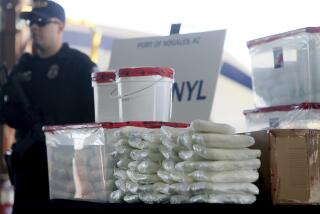U.S., allies to integrate drug safety efforts
- Share via
WASHINGTON — Faced with the globalization of drug production, the United States is joining with Europe and Australia to inspect factories in countries such as China and India that make an increasing share of the active ingredients in medications.
Bush administration officials said Wednesday that the agreement would allow regulators to coordinate their inspections and share information, thereby covering a wider territory and more foreign facilities.
“What we are seeing is the maturing of a global market and we have to invent new tools to deal with a changing environment,” said Michael Leavitt, secretary of Health and Human Services.
The pilot program will concentrate primarily on facilities in third countries, such as China and India, which produce much of the world’s pharmaceutical raw materials, but which are sometimes beyond the reach of U.S. inspectors.
The globalization of pharmaceuticals took on new focus last spring after the blood thinner heparin -- made with active ingredients from a Chinese facility -- was linked to dozens of deaths and hundreds of severe allergic reactions in this country. The drug was recalled by Baxter International and the U.S. blocked imports from the Chinese company.
The Food and Drug Administration found the heparin was contaminated with a nutritional supplement that costs less, but mimics the real drug in routine tests for potency, and thus was not detected. Investigators suspected deliberate contamination. The FDA had not previously inspected the Chinese facility because of a mix-up. And neither had Chinese drug safety regulators, because the plant was registered as a chemical factory.
The FDA expects to soon open offices in three Chinese cities -- Beijing, Shanghai and Guangzhou. Thirteen employees would be assigned to work there.
Under the program announced Wednesday, authorities would share inspection schedules, results and other information. The goal is to try to reduce duplication and identify potential problems more quickly. The U.S., the European Union and Australia have similarly stringent safety standards, so coordinating inspections seemed like a natural next step, regulators said.
“The FDA and its trusted colleagues can spread the inspection net wider,” Leavitt said. “Facilities will be inspected more often. However, the FDA would still retain the option of going into a facility that already has been inspected by another country.”
More to Read
Sign up for Essential California
The most important California stories and recommendations in your inbox every morning.
You may occasionally receive promotional content from the Los Angeles Times.













